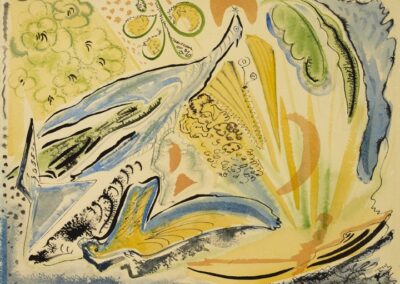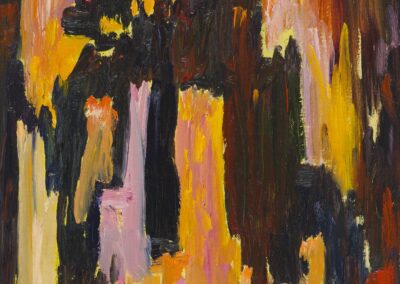Our next Artist You Need To Know is Alexandra Luke (1901 – 1967). Luke was a Canadian abstract artist who was essential to the group of artists known as Painters Eleven. Besides being one of the most significant artists of that group Luke was also a vocal advocate for contemporary Canadian art.
Her words : “Modern art tends toward the elimination of photographic realism and should be as pure an art as music… its medium, colour, is as elemental as sound and when properly presented is as capable of engendering aesthetic emotion as is music.”
Born in Montréal (with a twin sister), Luke’s family were from Oshawa and would return there in 1914 after she graduated high school. She initially trained to be a nurse in the United States. Luke married in 1925 but was widowed a brief four months later: she would remarry into the McLaughlin family. This is worth mentioning as this union laid the groundwork for what would be the Robert McLaughlin in the city of Oshawa, which was founded in 1967.
The quote cited from the artist earlier in this essay is from a letter Luke wrote to a local Oshawa paper in 1933 in support of the many Canadian artists breaking new ground in abstraction. Luke began painting in her late twenties, and was primarily self taught, making her own way for first part of her career.
Alexandra Luke was “44 years old when the former nurse, then homemaker and wife of General Motors heir Clarence Ewart McLaughlin enrolled in the Banff School of Fine Arts” (A.Y. Jackson of the Group of Seven was one of her instructors) in 1945 (from Museum London).
But the most significant influence on her in that space was Jock Macdonald, as Macdonald spurred Luke’s nascent interest in abstraction. Later (1947 – 1952) Luke encountered Hans Hofmann as a teacher (she often spent some summer weeks each year in Provincetown, MA, attending the Hans Hofmann School), and this grew from simply being a teacher into ongoing support and friendship that was intrinsic to her development as an artist. During this same period, the writings of E. E. Cummings / e e cummings and Gertrude Stein, as well as the works of Wassily Kandinsky and the wider ideas of Surrealism helped shape Luke’s aesthetic and ideas.
More of Luke’s words : “Painting should not stop with the already discovered beauty but continue searching.”
Her exhibition record is impressive : she was in the New York Show of Canadian Women Artists (1947) and was included in several major group exhibitions in the early 1950s, such as the Canadian Group of Painters and the Picture Loan Society (both in Toronto). Luke’s first solo exhibition was at the Picture Loan Society in Toronto in 1952. In that same year, Luke was the primary force behind the first Canadian all-abstract show titled the Canadian Abstract Exhibition : this travelled across Canada and was the genesis for the Painters Eleven group as all but two of the artists who would comprise that group were in this show. The Simpson’s Abstracts exhibition in 1953 was a further step forward and the first ‘official’ meeting of the group happened at Luke’s cottage studio in Oshawa / Whitby. From that year – until the collective dissolved in 1960 – Luke was one of the mainstays of any and all of their exhibitions. Along with Hortense Gordon, Luke was one of only two women in Painters Eleven.
Other notable exhibitions include several posthumous retrospectives, most notably at The Robert McLaughlin Gallery (1987, 1977 and 1969, respectively) and at the Alexandra Luke Gallery, in Bracebridge, ON in 2002. Luke’s work can be found in the collections of the National Gallery of Canada (Ottawa), The Robert McLaughlin Gallery (Oshawa, ON) and Museum London (London, ON).
Curator, writer and artist Margaret Rodgers published a book about Alexandra Luke titled Locating Alexandra in 1995 : This “in-depth look at the professional and private life of Alexandra Luke explores the tensions between Luke’s multiple selves. As Margaret McLaughlin [her ‘married’ name, if you will], she played the role of a married, society woman living in Ontario in the 1940s and 50s; but as Alexandra Luke, she broke into the male-dominated world of art, establishing Painters Eleven (the first abstract painting group in English Canada). Aided by commentaries from Luke’s friends, relatives, and acquaintances, Margaret Rodgers unravels the ideological, sociohistorical, and intertextual threads of Alexandra Luke’s life.”(from here)
Alexandra Luke passed in 1967 from ovarian cancer : she was actively painting and a strong advocate for the arts to the end. As previously mentioned in this essay, Luke was essential to the creation of The Robert McLaughlin Gallery in Oshawa : she and her husband “offered major financial support and works from their own collection toward the creation of a public art gallery for the City of Oshawa [which] became The Robert McLaughlin Gallery, named after [her husband] Ewart’s grandfather, in 1967.” (from here) This is as much Luke’s legacy as her paintings and groundbreaking works with Painters Eleven.
“Painting is like life itself: you learn as you go along, what to select, what to leave out — this is very important, what goes with what, how to get interest and excitement with unity and balance, how to take the bad days with the good and last but not least how to enjoy and learn at the same time.”
























